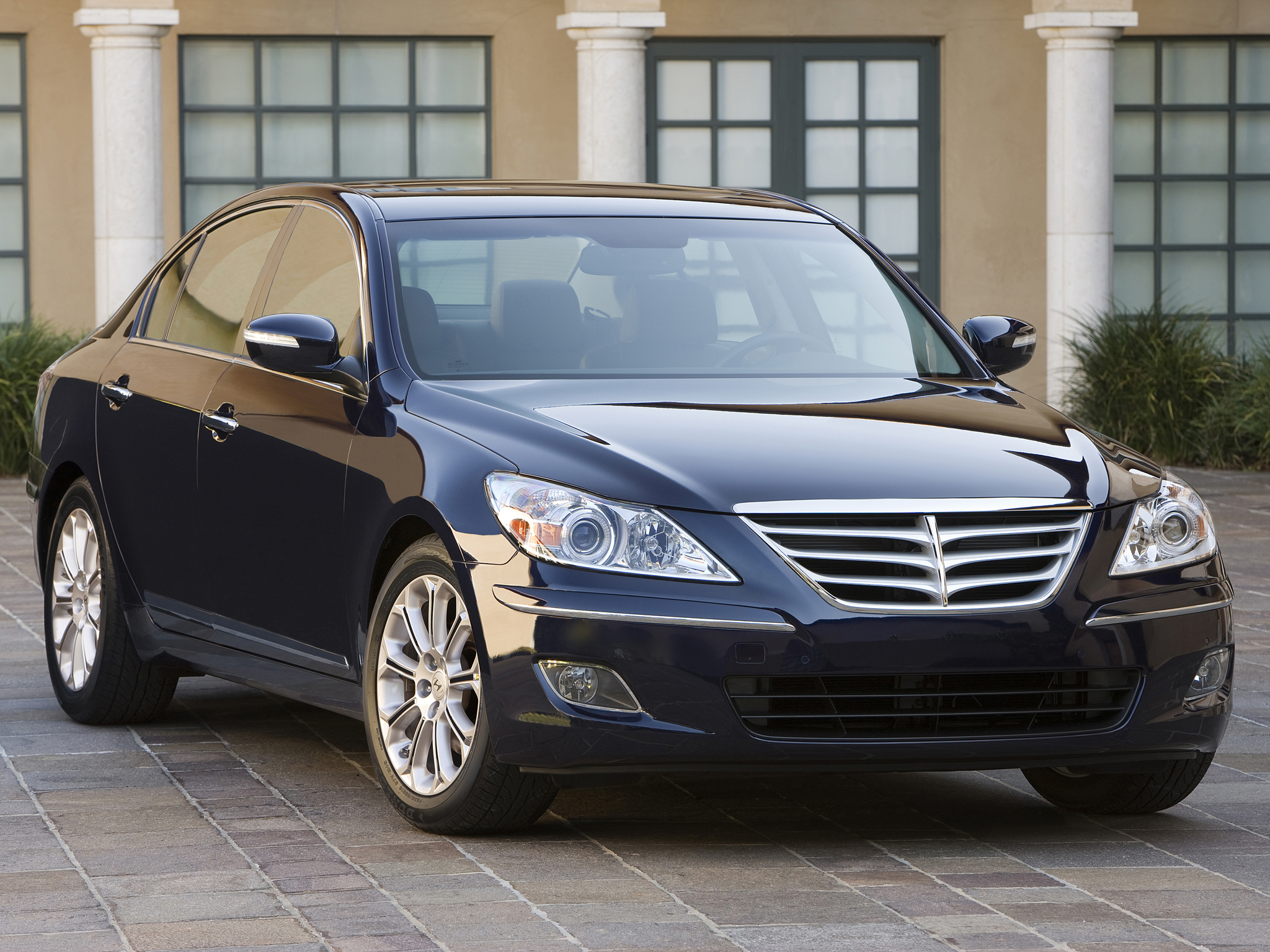Recent Articles
Popular Makes
Body Types
2009 Hyundai Genesis Review
If this doesn’t change your mind about Hyundai, nothing will
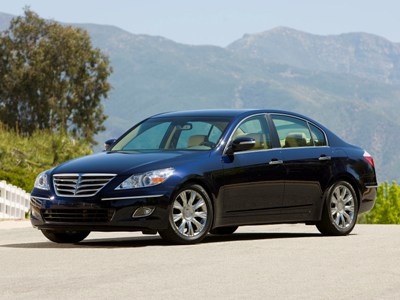
The Hyundai Genesis is an all-new vehicle for Hyundai, and is the company’s first V-8 rear-drive luxury sedan. It’s designed to be the equal of cars such as the Mercedes-Benz E-Class, and BMW 5 Series and Lexus GS sedans, but at a significantly reduced price.
Chrysler 300, Pontiac G8, Lexus GS
It’s not often that a car company knocks one out of the park as comprehensively as Hyundai has with the Genesis. It possesses the power, luxury and poise of a much more expensive sedan, with almost zero compromise. If this doesn’t change your perception of Hyundai, it’s likely nothing will.
One of the neat things about being an automotive journalist is that once in a while, you get to see a real sea change. One of these happened 20 years ago, when Acura and later the Lexus and Infiniti brands debuted, altering our perspectives of what a luxury car could be, and convincing us that it didn’t have to bear a German nameplate.
Just a few days ago, we were there when another very similar event occurred. Once again, it was the debut of an exceptional luxury sedan, and again, it came from an unexpected source. This time around, the car is the 2009 Hyundai Genesis, and in its own way, it is just as significant a debut as the first Acura Legend, Lexus LS 400 and Infiniti Q45. Genesis is probably the most appropriate name the company could come up with, as the word is defined as the origin of something significant. With a 375-horsepower V-8, rear-drive, a roomy and luxurious interior and all the technology doodads you’d expect in a modern luxury sedan, the manufacturer makes no bones about offering Mercedes-Benz levels of luxury and performance at, well, a Hyundai price. Executives even talk about two levels of competition: price competitors such as the Pontiac G8 and Chrysler 300, and “image” competitors which include the BMW 550i, Lexus GS 460 and Infiniti M45.
Yet unlike Honda, Toyota and Nissan, Hyundai chose to introduce its new luxury car as a Hyundai, and not under a new luxury brand. Carrying that corporate logo on the trunk is a risky move, if there is any one X-factor to this car’s success or failure it may be that chrome “H.” While the Genesis is an excellent sedan by any objective or subjective measure, the fact that it shares the showroom and brand name with Accents and Elantras, may be hard for some to accept. In our opinion though, if luxury car buyers pass up the Genesis for that reason alone, they’re simply missing the point: Hyundai is doing more than just entering a new segment with the Genesis, it’s firmly establishing itself as a capable builder of high-end cars, something it has been building up to for some time now, even if you haven’t noticed.
Page 2
There are two Genesis models available, one powered by a V-6 and the other by the company’s new V-8. The V-6 sedan starts at $33,000 including a $750 destination charge. However, there’s little that’s “base” about this sedan: standard equipment includes dual-zone automatic climate control, leather upholstery, heated power front seats, push-button start, leather-wrapped steering wheel with integrated audio controls, heated outside mirrors with integrated turn signals, an iPod input, and Bluetooth for cell-phone integration. It also includes a six-speed automatic with manual shift control, four-wheel independent suspension and anti-lock brakes, stability control, and acoustic glass in the windshield and front side windows.
Three options packages are available for the V-6 models. The Premium Package includes a leather-wrapped dash, sunroof, memory for the seats and mirrors, power tilt and telescope steering column, a power rear sunshade and an upgraded Lexicon surround sound audio system. It only costs $2,000, a price that seems completely reasonable to us. For $3,000 you can get the Premium Package Plus, which includes all of the above and 18-inch wheels and tires to replace the standard 17s. A Technology Package bundles an even better 17-speaker Lexicon audio system with a six-disc DVD changer, rear backup camera, touch-screen navigation, HID auto-leveling and adaptive headlights, a cooled driver seat, and other goodies for $4,000. If you’re keeping track, you’ve already figured out that driving off in a fully loaded Genesis V-6 will cost you $40,000.
Step up to the V-8 model and you get not only the larger engine, but pretty much everything in the V-6’s Premium Plus Package as standard equipment. You’ll also enjoy a wood-trimmed steering wheel, ”ultra-premium” leather upholstery, illuminated scuff plates, auto-dimming outside mirrors, and chrome body-side trim instead of the body-colored stuff on the V-6. That runs you $38,000, including the destination charge. The only option is the Technology Package, which offers up the same stuff as it does in the V-6 and costs the same $4,000, for a total of $42,000.

Page 3
The two engines available in the Genesis make no apologies to their Japanese and European luxury car contemporaries. The V-6 boasts 290 horsepower and 264 lb.-ft. of torque from its 3.8-liters of displacement. That’s more than respectable; it makes it one of the most powerful engines in its class. It’s connected to a six-speed automatic built by Aisin that features manual shift control through a special gate, and drives the rear wheels.
The V-8 is Hyundai’s first, and it’s one hell of a first effort. Output from its 4.6 liters is 375 horsepower and 333 lb.-ft. of torque. That’s more power than a Lexus GS 460, a BMW 550i or an Infiniti M45, although it lags in torque behind all three. It too is connected to a six-speed automatic with a manual mode, this one produced by German manufacturer ZF. Both the V-8 and V-6 models feature the same sophisticated multi-link front and rear suspensions designed to offer an ideal balance between ride and handling.
However, there are more differences between the two models than just engine choice. The steering on the V-8 uses an electro-hydraulic power assist, which is intended to offer the feeling of a standard steering system, but without the fuel-consuming parasitic drag of a belt-driven hydraulic pump like on the V-6 model. The brakes are also different. The V-6 models get 12.6-inch discs gripped by two-piston floating calipers in front and 12.4-inch discs in the rear. V-8 models up the ante with 13.0-inch discs gripped by four-piston fixed calipers, which are stiffer than the kind used on the V-6 models and thus help generate better stopping force.
In the past, Hyundai’s vehicles have been on the heavy side, and this is something the company wanted to rectify with the Genesis. To that end, the company has used high-strength steel in 74 percent of the car’s body, and used structural adhesives extensively in its construction. The upshot is a sedan that weighs 3,748 lbs. in V-6 form and 4,012 lbs. with the V-8, which is very competitive for this class.
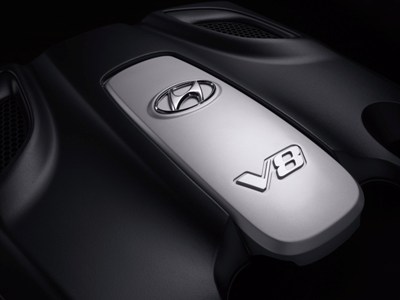
Page 4
During our test drive of the Genesis, we evaluated two models: a base V-6 with none of the options packages and a fully loaded V-8. The first thing you should know about the V-6 model is that it is no performance slouch. With 290 horsepower on tap, it provides plenty of power to get this big sedan moving quickly. Thanks to the extensive sound deadening, you don’t hear much of it until it gets to higher revs; at that point it’s a little harsh, but not nearly enough to set your teeth on edge. The Aisin-sourced six-speed automatic works just fine in fully automatic mode, but it’s also good to use in the manual mode as well; just slide the shifter into a special gate to the right of the main PRND, and slap it forward or backward to up or downshift. While we wish it would match revs on downshifts, we were otherwise impressed with the speed of gear changes. It even got decent fuel economy, returning 22.6 mpg on our test loop.
Step up to the V-8, and you immediately feel the difference 85 horsepower makes. While we’d prefer more low-end torque for a better kick in the shorts when launching from a dead stop, the V-8 more than makes up for it with strong mid- and high-range power. Lay on the throttle for 5.7 seconds, and Hyundai says you should be going 60 mph. Stay in it for a little longer and you’re easily into triple-digit speeds, where the Genesis remains calm and poised. Passing power was plentiful, and whether we let the six-speed pick its own gears or made our own choices, the changes were quick and uneventful. Fuel economy was decent, at 18.3 mpg during our admittedly lead-footed drive, and as for noise, we wish that Hyundai had let a little more of the V-8’s growl into the cabin. Listen closely and you can hear the muffled roar of a caged beast; with the right tuning, this could be a great sounding engine.
The only real letdown in both drivetrains is the programming of the automatic transmissions’ manual mode. In both vehicles, the transmission will upshift when you reach redline; we’d much rather have it stay in the gear we pick, and if it hits a rev limiter, then so be it. However, that’s a complaint we have of many transmissions of this type, not limited to Hyundai.
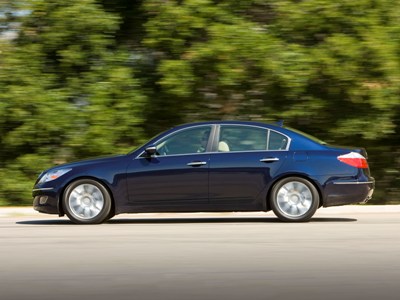
Page 5
The test route Hyundai laid out for us was ambitious, to say the least. Starting in Santa Barbara, Calif., we headed east over the mountains to Buttonwillow Raceway in Buttonwillow, Calif. The roads took us through tightly twisting mountain passes, long high-speed sweeping turns, straights that went on for miles, and even a little bit of urban commute and Interstate action. The racetrack experience gave us a chance to test the Genesis unfettered by the fears of law enforcement or plunging into a ravine.
The first thing we noticed about the Genesis is that the suspension is tightly controlled. It’s not harsh in the least, but if you’re expecting a mushmobile, you’re in for a shock; this big comfy four-door has the moves of a sport sedan. The steering is quick and precise, with good feedback for the driver. The suspension is compliant enough to soak up most bumps, so you’re rewarded with a ride that’s smooth under all but the harshest conditions. Yet there’s admirable control of body roll and the car is easily controllable in quick side-to-side maneuvers.
But that’s on the street; how does the Genesis do on a track? Pretty well, actually. Given enough room to play, the Genesis is downright entertaining. The car’s suspension is surprisingly balanced, and we found that the rear end was willing to break loose in a comfortably controllable way, even with the stability control in its fully active mode: Note that you can’t shut it off all the way in the Genesis, just make it less antsy about losing grip. On Buttonwillow’s East Loop – which is a tight and technical handling course – many journalists preferred the V-6 model thanks to its slightly better weight distribution, with more weight over the rear tires than the V-8. However, the power of the V-8 was undeniable, with the large engine pulling the car quickly from corner to corner.
We were also impressed with the brakes, both on and off the track. The pedal feel is firm, and the brake force is progressive. We thought that even the smaller brakes on the V-6 sedans were still very good, with little fade even though we literally got them smoking hot on the racetrack. That’s not to say that there’s no benefit to the bigger brakes on the V-8 models; they allowed us to brake later and carry more speed to the corners, again, without fade.
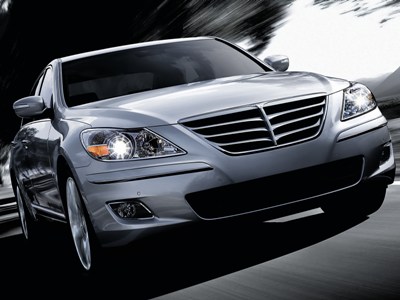
Page 6
There are a lot of sedans out there that boast handling and acceleration that belie their size. However, the compromises in them are often apparent from the inside: cheap interior materials, loud on-road rides, or uncomfortable seats covered in thin leather.
There are almost no such compromises in the Genesis.
From the moment you sit behind the wheel, especially in the V-8 models, you’re aware that this is a luxury sedan. The surfaces are soft-touch and high-quality, with the lone exception of one hard plastic piece on the driver’s side under the dash. The leather is soft and comfortable, doubly so in the V-8 versions with their “ultra-premium” cowhides, which really do feel Lexus-soft. The driving position is excellent, and the seats are supportive both for long-distance driving and high-speed action. The electric steering column is a nice touch, although we wish base models also had a telescoping column, even if it was just manual. There is soft leather covering the door panels, door armrests and center console armrest, and the door sill is also padded, although it’s on the narrow side which makes it a less than ideal place to rest your elbow. The front seats get standard heaters regardless of the trim level; in V-8 models they also get a cooling function if you opt for the Technology Package.
There’s certainly no problem with room, regardless of where you’re sitting. The front passengers have plenty, with wide, comfortable seats, lots of head and leg room, and plenty of ways to get comfortable. The rear passengers are also coddled, with comfortable chairs, plenty of leg room, and enough head room to satisfy all but the freakishly tall. The climate controls are all automatic, regardless of the model you choose, and rear seat passengers get their own vents mounted on the pillar between the front and rear doors.

Page 7
A modern luxury car must have presence, style and poise. If there’s one knock against the Genesis it’s not that it lacks these things, but that it fails to make an individual styling statement. On one hand, a $40,000 luxury car from Hyundai is probably already enough for most people, so saddling it with a new styling paradigm may have pushed things too far. Still, there’s too much Lexus, Mercedes-Benz and BMW in the design to make it truly stand out from the crowd.
That’s not to say that it’s a bad looking car, because it’s not. Quite the contrary, Hyundai has certainly cribbed in all the right ways. It has the profile of an LS 460, a grille treatment that’s somewhere between that car and an S-Class Benz, and in the hindquarters, there’s a hint of the bustle-back look started by BMW in the 7 Series. To look at the Genesis is to look at the best elements of its image-competitors, and though we’d prefer more distinction, we can’t argue with the results. One thing to note about the exterior styling: Unless you’re familiar with the Hyundai “H” logo, you’d be hard pressed to tell who makes this car. The badge appears only on the center of the trunk lid, and the word “Hyundai” is absent entirely. Perhaps the company is hoping you’ll keep thinking “Lexus” for as long as possible when you first view this car.
The interior is also conventional, with no new ground broken, but it still speaks the common language of luxury well. Base models get faux wood trim that’s convincing enough, but opt for the Premium Package – or choose the V-8 – and you get leather trim in its place; Hyundai’s claims of a “leather-wrapped” dash are exaggerated, but it is unusual to see leather on the dash of a car at this price. Of the three interior décor schemes we saw, we liked the combination of black and saddle leather the best, with the dark brown leather looking particularly elegant against the black and satin-finish metal surfaces inside.
The interior is also functional, with all the knobs and switches within easy reach, and all of them marked clearly enough so that there’s almost zero acclimation time in this car. The Technology Package introduces a large knob mounted centrally on the console to the interior; it controls things like the navigation system, audio functions and so forth. However, while it bears a superficial similarity to BMW’s iDrive and Audi’s MMI, it is much more intuitive and simpler to use.
Storage capacity is only so-so, with hinged door pockets in front and two cupholders in the center console in front of the deep two-tier bin. The glovebox is on the small side though, and we wish for a few more small pockets here and there for items like an iPod or cell phone. Rear seat passengers get two cupholders integrated into the fold-down armrest, and the design merits a note: The cupholder itself is covered with a soft lid, so if you’re not using it to store beverages, you still have plenty of room for your arm. There’s less elbow room if you’re actually using it to hold a cup, but it’s still adequate. Door and seatback pockets round out the storage for rear seat passengers. Behind them is a large trunk with hidden hinges and a nice low liftover that was capable of swallowing several bags worth of video gear with plenty of room to spare.
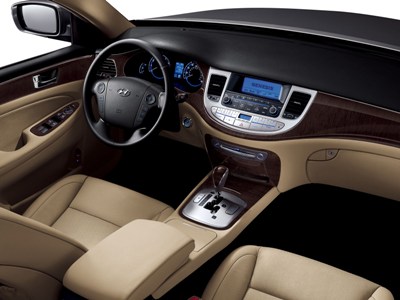
Page 8
2009 Hyundai Genesis V-6 $33,000 (includes a $750 destination charge) 3.8-liter V-6 290 at 6,200 rpm 264 lb.-ft. at 4,500 rpm Six-speed automatic 3,748 lbs. 18/27 mpg 22 mpg 195.9 in. 74.4 in. 115.6 in. 58.1 in. 44.3/38.6 in. 40.4/37.7 in. Five 15.9 cu. ft.
By Keith Buglewicz Photo credit: Hyundai
